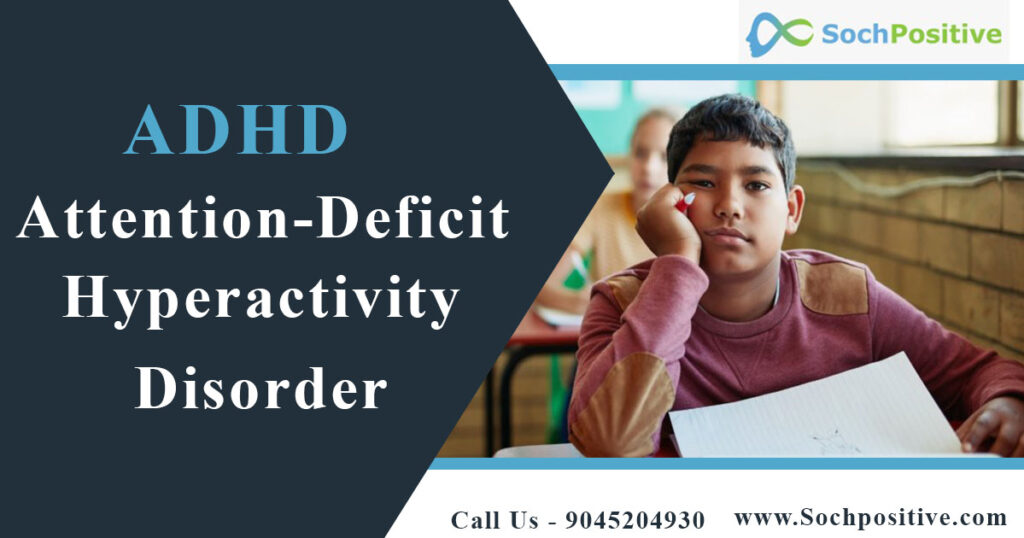Author: Krish Virmani
Keywords: ADHD, Causes, Diagnostic Criteria, Treatment, Prevention
Attention-Deficit Hyperactivity Disorder, or ADHD, is a relatively common mental disorder that is generally diagnosed in young children often based on concerns regarding performance and behaviors in school and home. The children affected with ADHD commonly exhibit hyperactivity, inattention, and/or impulsivity and are highly distractible. Although most individuals have symptoms of both inattention and hyperactivity-impulsivity, one or the other pattern may be predominant. This often leads to an overall negative self-evaluation, lower self-esteem, and negative emotions as individuals find it difficult to compete with their peers. Therefore, it is important to treat it as soon as possible to avoid long-term negative outcomes pertaining to academics, interpersonal relationships, and eventually employment. The diagnosis for the disorder proves to be relatively complicated as it can have similar symptomology as other problems such as anxiety, depression, as well as certain types of learning disabilities.
Diagnostic Criteria
The current diagnostic criteria outlined in the Diagnostic and Statistical Manual of Mental Disorders, (DSM-5) require that a child’s behavior be developmentally inappropriate (i.e., the child’s behavior is substantially different from other children of the same age and developmental level) and that the symptoms must begin before age 12 and be present for at least 6 months; must be present in two or more settings; must cause significant impairments in home, school, occupational, or peer settings; and must not be secondary to another disorder.
Based on the nature of symptomology, the DSM-V states that ADHD can have three different kinds of presentations:
- ADHD, predominantly inattentive: some frequent symptoms include an inability to pay close attention, problems sustaining focus, and forgetfulness. The above symptoms can manifest in the form of careless mistakes, shabby or disorganized work, and a general apprehension for activities that demand attention.
- ADHD, predominantly hyperactive-impulsive: Being the least common form of ADHD, it is characterized by hyperactivity and the need to move constantly. This lack of patience can lead the individual to engage in disruptive behaviors, and fidgeting. Further, such individuls are privy to engage in impulsive decisions, making them increasingly prone to accidents and injuries.
- ADHD, mixed: Symptoms of the above two types are equally present in the person.
A diagnosis of ADHD is made primarily in clinical settings after a thorough evaluation which includes a careful history and clinical interview to rule in or to identify other causes and contributing factors, behavior rating scales, a physical exam, and any necessary or indicated laboratory examinations. It is important to systematically gather and evaluate information from a variety of sources, including the child, parents, teachers, and physicians.
Causal and Risk Factors
Like most mental illnesses, experts have had a rough time pointing to the exact causes of ADHD, however, there seems to be general consensus on the genetic and neurobiological basis of the illness. While genes are considered to have a significant role in developing the condition, there are other risk factors involved such as exposure to environmental toxins, maternal drug use, premature birth as well as trauma sustained to the brain through an impact or epilepsy.
Coexisting Conditions
While ADHD doesn’t itself cause other psychological and physiological problems, there are several other psychiatric disorders that regularly appear alongside it (see table 1). In addition, afflicted individuals often face a delay in speech, language, motor, and social development. The core ADHD symptom of impulsivity has been linked to numerous other functional impairments, including engagement in risk behaviors that affect health and safety, such as poor driving performance and accidents, arrests, alcohol and substance abuse, smoking, acquisition of sexually transmitted diseases, and early pregnancies.
Table 1.
Comorbidity rates of ADHD with other conditions
| Disorder | Comorbidity Percentage |
| Learning Disabilities | 15-20% |
| Oppositional defiant disorder | (ODD) 50% |
| Conduct Disorder | 7-20% |
| Language Disorders | 30-35% |
| Mood Disorders | 5-20% |
| Substance Use | 25% |
| Anxiety Disorders | 20-33% |
Diagnosis of Adult ADHD
Research suggests that even though ADHD cannot emanate during adulthood, it can definitely continue from childhood and worsen as the demands of adult life increase. Adults are exposed to a variety of social and professional situations that can provide an opportunity for previously unnoticed symptoms to manifest.
As patients mature and their roles and responsibilities evolve, the impairments and symptoms evolve in response. Previous symptoms related to inattention may present as difficulty in completing tasks, poor time management, difficulty in sustaining attention in work-related activities, distractibility and forgetfulness, and poor concentration. While hyperactivity is assumed to fade or resolve as individuals grow older, research suggests that the behavioral symptom cluster is internalized in the form of cognitive restlessness.
Treatment and Prevention
While ADHD can be managed using either medicine or therapy, a combination of both is usually recommended by most mental health practitioners. Medications that are licensed for the treatment of ADHD aren’t considered to be permanent cures but seek to relieve symptoms of inattention, impulsivity, and concentration loss allowing for individuals to better control their behaviors that cause difficulties.
Before one can begin treating the individual, it is important to make sure that a proper understanding of the illness has been reached between the practitioner and the clients, which includes any parents/caregivers. Such an understanding can be achieved through the use of psychoeducative discussions, where the practitioner discusses all possible factors associated with the management and prognosis of the illness.
Two common forms of therapy that seem to be effective at providing support include Behavior Therapy(BT) and Cognitive Behavioral Therapy(CBT). The main tenet of BT revolves around identifying faulty behaviors and trying to modify them into desirable behaviors through the use of Behavioral techniques such as modeling and conditioning. However, CBT takes it a step further by addressing the cognitive component of the aforementioned faulty behaviors as well as providing means of changing the same. Through the help of a therapist, the individual seeks to alter their thoughts and feelings which leads to a change in the overall behavior. In addition, it is also suggested to take up skills training to better rehabilitate the individual into the society.
Lastly, It is important to discuss certain preventive measures against ADHD:
- focusing on maternal health during pregnancy, including abstaining from alcohol and ciggarettes.
- Reduction in environmental toxins
- Early diagnosis; leading to better interventions designed to reduce (or eliminate) the likelihood of severe consequences.
References
(2015)Committee to Evaluate the Supplemental Security Income Disability Program for Children with Mental Disorders; Board on the Health of Select Populations; Board on Children, Youth, and Families; Institute of Medicine; Division of Behavioral and Social Sciences and Education; The National Academies of Sciences, Engineering, and Medicine; Boat TF, Wu JT, editors. Mental Disorders and Disabilities Among Low-Income Children. Washington (DC): National Academies Press (US);, Clinical Characteristics of Attention Deficit Hyperactivity
Disorder. Available from: https://www.ncbi.nlm.nih.gov/books/NBK332879/
Centers for Disease Control and Prevention. (n.d) Attention-Deficit / Hyperactivity
Disorder (ADHD). Retrived from: https://www.cdc.gov/ncbddd/adhd/facts.html
Halperin, J. M., Bédard, A. C., & Curchack-Lichtin, J. T. (2012). Preventive interventions for ADHD: a neurodevelopmental perspective. Neurotherapeutics : the journal of the American Society for Experimental NeuroTherapeutics, 9(3), 531–541. https://doi.org/10.1007/s13311-012-0123-z
Neeuro (2020) Millions of Indian Children (and Parents) Struggle with ADHD Medications. Retrived from: https://www.neeuro.com/blog/adhd-india
Reinhold, J.A.(2015) Adult ADHD: A Review of the Clinical Presentation, Challenges, and Treatment Options. Psychiatric Times. Retrived from: https://www.psychiatrictimes.com/view/adult-adhd-review-clinical-presentation-challenges-and-treatment-options






